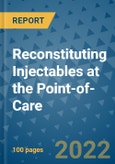Reconstituting Injectables at the Point-of-Care is a comprehensive evaluation and analysis of the technology, products and participants providing the driving force behind this evolving segment of the healthcare sector. The study is designed to provide drug company decision makers, drug delivery developers, device designers, healthcare marketers, and supply chain participants with a detailed understanding of the economics, technologies, disease segments, and commercial opportunities for reconstitution systems for injectable drug products. Provider organization business managers, healthcare administrators and investors will also benefit from this study.
Engineered Injectables that Address Chronic Conditions
The inherent instability of biological drugs is a limitation that has a direct impact on the drug delivery sector. Therapeutic proteins must either be stored under special conditions or formulated to retain their efficacy from the time of manufacture until they are dispensed. Liquid protein drugs require refrigeration until dispensed. Alternatively, proteins can be formulated as powders (lyophilization) and must be reconstituted prior to injection. Historically, this was accomplished by including a disposable syringe and diluent vial for manual reconstitution. As the number of drugs developed for self-administration has grown, devices that integrate a reconstitution step with the injection step have gained traction. As biological drugs continue to grow in terms of therapeutics and total prescriptions, the impact of specialty devices will increase.
What You Will Learn
- What is the impact of lyophilized injectable drugs on today’s therapeutic market, how are they packaged, and who markets them?
- Who are the suppliers of integrated reconstitution devices, and what is their market impact?
- What are the major factors driving the demand for integrated devices for injectable drug reconstitution?
- What is the relative impact of integrated reconstitution systems to OEM or standalone reconstitution devices and how will this change by the end of the decade?
- What are the essential design factors, material selection issues, technologies and market development issues for drug reconstitution systems and devices?
- What is the role of integrated drug reconstitution systems on drug life cycle management?
- What are the significant economic, technology, and regulatory factors affecting the market for injectable drugs and reconstitution systems in particular?








